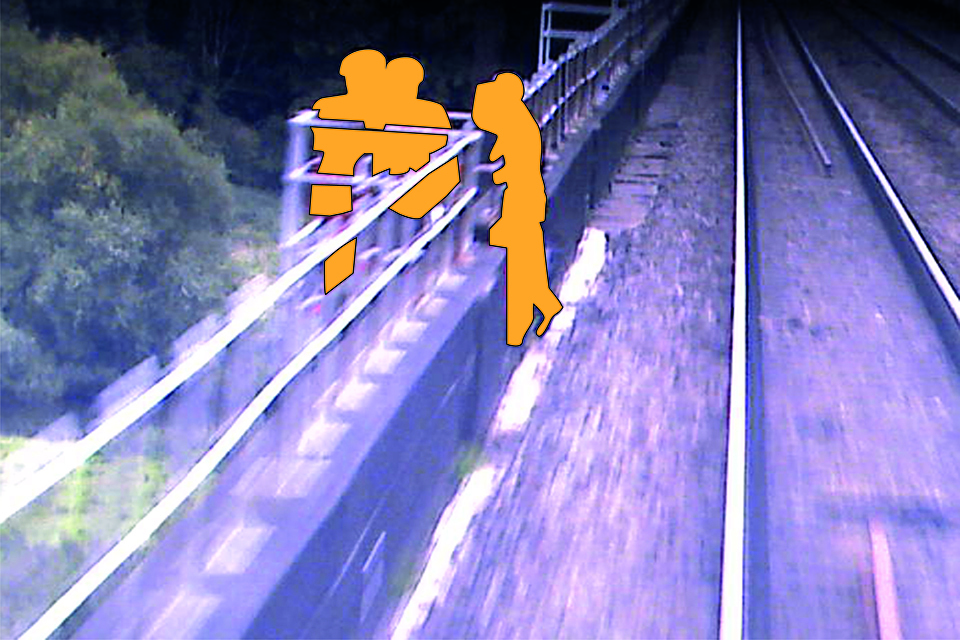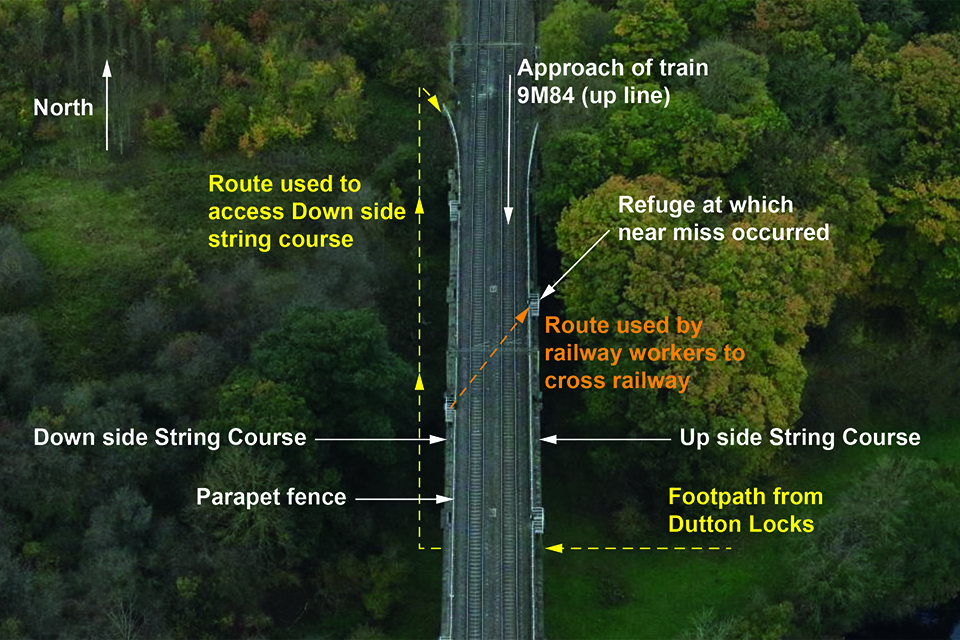Near miss between a train and line-side workers on Dutton Viaduct, Cheshire, 18 September 2017
Published 4 December 2017
1. Important safety messages
This incident demonstrates the importance of:
- never entering the railway in a red zone prohibited area while lines are open to traffic
- challenging unsafe behaviours within a work group, even if the person in charge of safety has instigated or agreed to an unsafe act and invoking, when appropriate, a ‘Worksafe’ or similar procedure
- promptly and accurately reporting near miss incidents
- ensuring that the planning process for a safe system of work includes careful consideration of safe access and egress routes from the railway, using authorised access routes
- ensuring that deviations from a planned safe system of work are properly considered and authorised by a responsible manager
- responsible managers testing the effectiveness of their processes to assure themselves that there is compliance with procedures and a positive attitude to safety amongst their staff
2. Summary of the incident
At 16:57 hrs on 18 September 2017, a passenger train travelling at 125 mph (200 km/h), encountered three line-side workers on Dutton Viaduct. The last of the workers moved clear of the track less than half a second before the train passed him. None of the workers were injured, but the train driver was shaken by the incident. The train involved was 9M84, the 14:00 hrs service from Glasgow Central to London Euston.

Image from forward-facing camera on train 9M84 as it crosses the viaduct. The group of line-side workers moving clear are represented by yellow outlines as the move to a refuge (image courtesy of Virgin Trains)
Dutton Viaduct is located on the West Coast Main Line between Crewe and Weaver Junction, and spans the Weaver Navigation waterway. It is a large stone structure and conveys a double track railway.
The permitted line speed of the railway on the viaduct is 125 mph (200 km/h). Because of the limited space available on the viaduct to stand clear of passing trains, the viaduct is a ‘red zone prohibited area’. This means that railway staff are not permitted to be on the viaduct whilst the railway is open to traffic unless they are separated from trains by a permanent fence. The viaduct has refuges which allowed workers to safely stand further back from passing trains when train speeds used to be lower. However, since the line speed was increased as part of the West Coast Main Line upgrade (completed in 2006), these refuges are no longer adequate to ensure safety.
The line-side workers had been carrying out a structural examination of the viaduct which required them to work from areas on either side of the viaduct which are separated from the railway lines by the permanent bridge parapet fence. Such work is permitted when trains are running.

A Google earth view of Dutton Viaduct crossing the river
Despite the prohibition of access to the railway lines (including the refuges) on the viaduct while trains are running, the group of workers chose to cross from a refuge on the down side of the railway to a refuge on the up side of the railway. Train 9M84 was approaching them on the up line as they were completing the crossing. The last worker managed to get into the refuge approximately half a second before the train passed the location.
The driver of train 9M84 reported the incident promptly to the Network Rail signaller. Subsequently the service had to be cancelled at Crewe because the driver felt unable to continue.
The line-side workers did not report the incident as a near miss to the signaller or their employer.
3. Cause of the incident
The near miss occurred because the group of workers made the decision to enter the down side refuge and then cross the open railway lines on the viaduct despite this being prohibited.
The workers’ employer, Bridgeway Consulting Ltd (Bridgeway) has a contract with Network Rail to carry out periodic inspections of Dutton Viaduct. Bridgeway’s task planning process originally envisaged using mobile elevating work platforms (MEWPs) to undertake the inspections from ground below the viaduct. However, during a planning site visit, this was found to be impractical. It was then decided that inspection would be carried out from the viaduct structure using rope-access techniques.
The viaduct has horizontal string courses along its length on both the up and down sides. Access to the string courses is available from the adjacent embankment without the need to first gain access to the railway tracks. The string courses form ledges that are approximately one metre wide, located at a level lower than the railway tracks and separated from the railway by the parapet fence. Access to the string courses is permitted when trains are running and each string course can be used as a working platform for the inspections of the viaduct. However, ropes must be used to ensure safe working on the string courses. To allow the use of ropes, anchor points must first be installed.

The north end of Dutton Viaduct, showing the parapet fence, string courses, path of the group and the refuge where the near miss occurred (image courtesy of Network Rail)
During the night of 16/17 September, preliminary work was carried out to start installing rope anchors to facilitate the following week’s work. The anchors were installed from the north end of the viaduct working south, but this work was only partially completed.
Bridgeway produced a task briefing sheet which specified two access points. One of these was at Cliff Lane, approximately half a mile (0.8 km) to the south of the viaduct. Cliff Lane is an authorised access point for the railway. The task briefing sheet also specified Dutton Locks as an access point. Dutton Locks is located approximately half a mile to the north-east of the viaduct along the Weaver Navigation. There is a public footpath which leads from Dutton Locks and underneath the north end of the viaduct. However, there is no authorised access point to the railway in this vicinity. The contents of the task briefing sheet were briefed to the work team by the site team leader on 18 September 2017 and each team member signed to acknowledge receipt of the brief.
A Safe System of Work (SSoW) Pack was also compiled by Bridgeway. This document detailed how safety would be assured whilst the task was undertaken. The SSoW pack only included one access point, Cliff Lane. It had been reviewed and accepted by the Controller of Site Safety (COSS) for the work to be carried out on 18 September 2017. Neither a SSoW pack nor a COSS were technically required for the task, because the site of work was separated from the operational railway by a permanent fence. However, in this case, Bridgeway provided both a SSoW pack and a COSS. The SSoW pack also included an extract from Network Rail’s Hazard Directory, which explicitly states that Dutton Viaduct is ‘red zone prohibited’. The contents of the SSoW pack were briefed to the work team by the COSS on 18 September 2017 and each member signed to acknowledge receipt of the brief.
On 18 September, a team of six Bridgeway staff arrived at Dutton Viaduct during daytime, when trains were running. Each person held the necessary competence certification to allow them to work on or near railway lines. Because the rope anchors they would need were only available at the north end of the viaduct, the team parked at Dutton Locks. The team walked to the viaduct and divided into two sub-teams of three staff. The red zone prohibition meant that the only way to move along the viaduct to carry out the inspections was by means of the string courses. One sub-team planned to work along the up side string course and the other along the down side string course.
Each sub-team climbed the embankment on their allocated side of the viaduct and got onto their respective string courses. The sub-team working on the down side, which included the COSS, encountered difficulties in gaining access to the string course due to dense vegetation and a fence which obstructed their path. Despite this, they got onto the down side string course. The other sub-team did not encounter any difficulty gaining access to the up side string course.
During the day, the team inspected the first five arches of the viaduct. When it was time to finish and return to Dutton Locks, the sub-team which had been working on the down side were concerned about the problems they had encountered with access that morning. They decided to cross the railway to gain access to the up side string course, and leave the viaduct by that route. The group climbed from the string course into a line-side refuge on the down side of the railway. Forward facing CCTV cameras on a northbound train captured images of the sub-team in the refuge, waiting to cross, at 16:54 hrs.

Image from a northbound train (on the down line) at 16:54 hrs. The down side sub-team can be seen in a refuge. The up side sub-team can be seen on the right, stood on the string course. (Image courtesy of Virgin Trains)
The group then crossed the railway lines from the down side to the up side. The refuge on up side was not directly opposite and so the group sub-team had to cross the lines diagonally which extended their crossing time. While they were crossing the up railway line, train 9M84 approached the viaduct round a left-hand curve, and the near miss occurred.
Although the members of the sub-team that crossed the lines had been briefed on the SSoW, and were aware that the viaduct was red zone prohibited, there is no evidence that anyone challenged the decision to cross the railway lines.
Both Network Rail and Bridgeway provide ‘Worksafe’ procedures for their staff, which allow staff to refuse to work in situations where safety is compromised.
Those involved did not report the near miss to either the Network Rail signaller or their employer Bridgeway. Both organisations have procedures for reporting such incidents and the team members were aware of these systems. It was not until Saturday 23 September that the workers involved had been identified by Network Rail and Bridgeway were advised of the near miss involving their staff.
4. Previous similar incidents
There have been and continue to be, numerous similar incidents. On 13 April 2017, the RAIB published a class investigation into accidents and near misses involving trains and track workers outside possessions (RAIB report 07/2017). The report made five recommendations and a learning point and identified many important safety messages which are relevant to this incident, such as:
- the need for those in charge of safety to properly identify hazards and assess the risks that they find on site
- the importance of non-technical skills such as risk perception, and the willingness to challenge unsafe decisions
You can print this safety digest.

